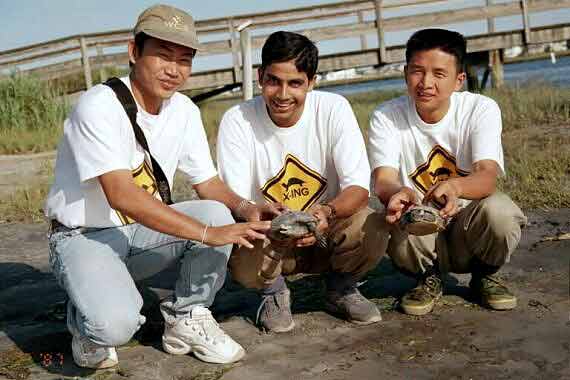

Asian Scholarship interns Nara Heng, Firoz Ahmed, and Jichao Wang
release terrapins after they nested on the Institute's Nature Trail.
 |

The 2002 Release of “Headstarted” Terrapins
in and around Stone Harbor, New Jersey
by Firoz Ahmed

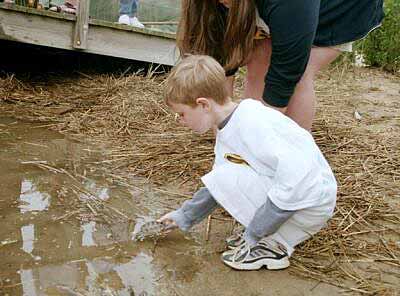

A young student from the Avalon/Stone Harbor
combined kindergarten releases a headstarter
at the Wetlands Institute on June 13.
 |

|

More than 700 female terrapins die every year on a 32-mile stretch of roads covered by the Terrapin Rescue Project road patrols. Viable eggs recovered from these roadkills are transferred to the science laboratory at Richard Stockton College of New Jersey for incubation. The hatchlings are then raised for ten months at the “Terrapin Farm” there until they are grown up enough to release and are presumably capable enough escape most predators. These are referred to as "headstarters."
All the headstarters are "microchipped." A rice grain–sized microchip is implanted subcutaneously in front of the hind leg. The chip can then be read for its unique number using a portable reader to identify the individual turtle.
One of the important objectives of the Terrapin Rescue Project at the Wetlands Institute is to involve the community in the conservation of the species. A large section of the community — students, teachers, parents, lawyers, administrators, and many others are involved in the release process under the auspices of the Wetlands Institute.
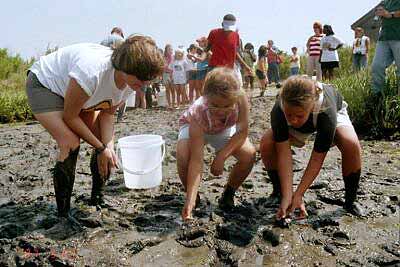

Christina Walter (left) helps two 4th graders release
head-started terrapins at the Wetlands Instittute.
 |

The first release this year was on the 6th of June with fourth graders from Quinton Elementary School. This year the students raised ten hatchlings, which they brought with them for releasing. Fellow interns Christina, Meredith, Joanna, and I microchipped them while Tom Mohrman, Research Assistant, and other interns told the students about the terrapin conservation program, how the headstarters are raised, and, of course, how to carefully handle the headstarters they were about to release.
Following the introduction, the students marched down the nature trail to the Wetlands Institute dock, and the territorial red-winged blackbirds buzzed the heads of us a few times before we reach the dock. Two students helped release each head-started terrapin. It was low tide and everybody had to walk into the mud along the shore of the creek. Some kids were not interested, but many were excited. A few enthusiastic students volunteered to initiate the release. The kids walked into the knee-deep mud and released the turtles. Some of us were standing in thigh-deep mud to get a good picture of the release event. The kids released 25 headstarters that morning, and afterward they were helped to wash the smelly mud off their legs. Oh, that was exciting! Some of them were shouting.
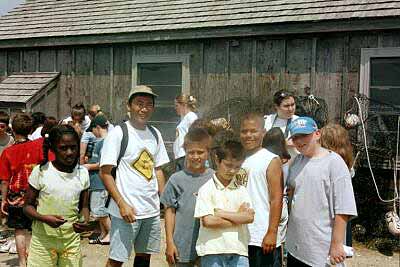

Sovannara Heng (center left) with 4th graders who
participated in the release of head-started terrapins
 |

The second release was at Strathmere, New Jersey on June 12 by seventh graders from Jordan Road Elementary School, Somers Point, NJ.
They released a dozen terrapins that day. It was a nice experience to talk to the students, who are very smart and well-informed. At the end of the release the students handed over to us a check for $100 raised by them through sale of turtle candy, which they made. They also have a Web site called Terrapin Troubles, where one can see photographs of the release program.
The Grand Release is so called because it is well organized, well attended, and well publicized in print and electronic media. On the 13th of June, 21 kindergarten students from the Avalon/Stone Harbor combined kindergarten arrived at the lecture hall of the Institute. Dr Roger Wood, Director of Research, hosted the release. We surprised the kids with a gift, a small-sized “Turtle Crossing” T-shirt, from the Institute. Each one of them was introduced to the turtle to be released by them. After a brief introduction by Dr Wood about the Terrapin Project, everybody marched to the dock. It was a high tide that day and not muddy like the earlier release. Each kid was guided by a studend researcher or educator from the Institute, who helped release the turtle in the water. The kids said “Bye bye, turtle . . .” Before the release, they handed over a check for $100 to the Institute, representing money they raised from selling “Turtle Cookies” made by them. A number of parents also attended the release program.
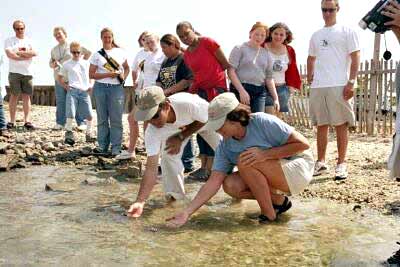

Nara Heng and seventh-grade teacher Mary Rydzewski
release a head-started terrapin on June 12.
 |

On June 19 we released a dozen headstarters involving more than 50 families who attended an educational program of the Institute. The lecture hall was packed, and we had to conduct a lottery to select 12 lucky families to release the headstarters. Before the release the families were briefed by Dr. Wood about the Terrapin Conservation Program. People were showed the eggs, week-old hatchlings, headstarters and adults, and the tagging of a terrapin by microchip.
On 23rd June we had a release event with the families of the Environmental Lawyers of New Jersey. The release was attended by four lawyers' families.
Conservation and the Community
The releases sponsored by the Wetlands Institute are an important step in the process of involving the community in the conservation of diamondback terrapins in New Jersey. It helps the people to know more about the terrapins that live in their neighborhood as well as give them the opportunity to involve themselves in the conservation of the species.
Every year approximately 250 headstarters are released in the vicinity of the Wetlands Institute. This is an attempt to compensate for the deaths of adult female turtles on the road. Moreover, this is a good fundraising initiative for the Wetlands Institute to partially support the Terrapin Conservation Program.
The terrapins released are all hatched at Richard Stockton College of New Jersey, and probably all of them are female because they are incubated at a relatively high temperature (which leads to the development of females). This is intended to help compensate for the annual loss of road-killed adult females during the nesting season. Although this does not totally compensate for these deaths, I think it is a good attempt towards the conservation of this species.
The eggs come from different localities throughout our road patrol area, so the headstarters are released at the different localities, not just at the Wetlands Institute's Dock.
We are looking forward to releasing approximately 200 headstarters in the next few weeks, involving still more people in the process.

|